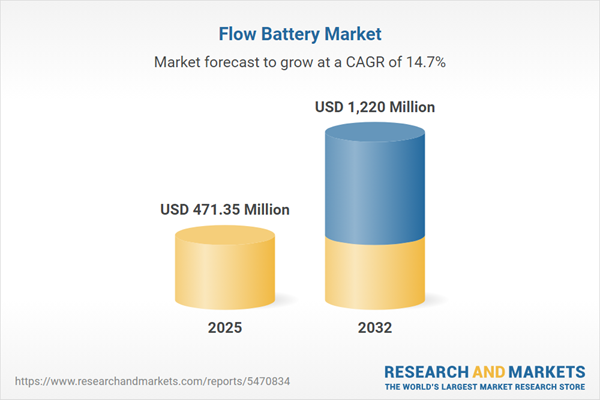Speak directly to the analyst to clarify any post sales queries you may have.
Flow batteries are emerging as a strategic solution for organizations seeking reliable, long-duration energy storage aligned with modernization and sustainability priorities. For senior decision-makers, understanding the evolving landscape of the flow battery market is essential to making informed infrastructure and procurement choices in increasingly complex operating environments.
Market Snapshot: Flow Battery Market Size and Growth
The global flow battery market is maintaining robust momentum, with a current valuation of USD 409.75 million in 2024 and a projected rise to USD 471.35 million by 2025. The market is on track to reach USD 1.22 billion by 2032, resulting in a compound annual growth rate of 14.71% over this period.
This upward trajectory is supported by increasing demand for scalable, grid-connected energy storage solutions. Key market growth drivers include the integration of renewables, the need for improved grid stability, enhanced risk management, and alignment with updated regulatory standards. Organizations across commercial, industrial, and utility sectors are adopting flow batteries to support reliable operations and long-term asset value.Scope & Segmentation of the Flow Battery Market
- Application Areas: Flow batteries serve grid storage, microgrid operations, renewable energy support, and off-grid deployments—enabling managed risk, operational resilience, and planned organizational expansion.
- Product Types: Main technologies include iron chromium, vanadium redox, and zinc bromine flow batteries, each offering specific performance and cost profiles tailored for varied energy management scenarios.
- End User Segments: The technology addresses commercial, industrial, residential, and utility requirements, with use cases ranging from backup power in critical facilities to reliability improvements in distributed assets.
- Storage Duration: Solutions span short-term emergency backup to multi-day, continuous supply, directly supporting uninterrupted operations in high-priority environments.
- Power Rating Categories: Available systems range from sub-1 MW distributed units to large-scale installations exceeding 10 MW, providing flexibility to match both localized and high-demand needs in various business contexts.
- Regional Coverage: Market development varies by region, driven by regulatory policies, access to qualified supply chains, and technology adoption rates. The Americas, Europe, Middle East & Africa, and Asia-Pacific each exhibit unique market opportunities dependent on regional priorities and readiness.
- Deployment Sectors: Implementation occurs in microgrids for campuses, telecommunications, defense operations, renewable generation sites, data centers, and oil and gas facilities, offering sector-specific approaches to resilience and system reliability.
- Market Influencers: Factors impacting market growth include regulatory frameworks, government incentive programs, advances in supply chain management, and collaborative models among technology and material suppliers.
Key Takeaways: Strategic Insights for Senior Decision-Makers
- Decentralized and modular designs in flow battery technology facilitate scaling and adaptation as operational demands shift or grow.
- Innovations in chemical processes and engineered components enhance system lifecycle, making transitions to alternative energy infrastructures less disruptive within established organizations.
- Greater visibility and traceability in supply chains support ESG objectives, ensuring both responsible sourcing and procurement security.
- With increased adoption of renewables and frequent energy storage cycles, organizations experience higher reliability and reduced risks of disruptions in critical business operations through advanced flow battery management.
- Cross-functional collaboration among engineering, procurement, and IT units is essential for the successful roll-out and optimization of new storage assets.
- The use of predictive maintenance protocols and robust asset management strategies leads to improved returns on capital investments and tighter alignment with enterprise objectives.
Tariff Impact on Flow Battery Supply Chains
Recent changes in U.S. tariffs are prompting manufacturers to refine supply strategies, encouraging broader supplier networks and increased domestic sourcing for key materials such as electrolytes and membranes. Enhanced collaboration between chemical suppliers and technology integrators is improving the availability of local materials and increasing overall supply chain resilience. As the regulatory landscape evolves, procurement leaders must proactively monitor cost structures and supplier arrangements to sustain efficiency and manage budget risks effectively.
Methodology & Data Sources
This analysis is informed by direct executive interviews, detailed evaluation of industry literature and patent trends, as well as cost modeling methodologies. Findings are verified through triangulation and peer review to ensure accuracy and credibility for senior decision-making.
Why This Flow Battery Market Report Matters
- Delivers strategic guidance to align energy storage planning with organizational goals in resilience, compliance, and sustainability initiatives.
- Equips leadership teams with actionable insights for swift adaptation to regulatory changes and global supply chain shifts.
- Provides tailored, sector-specific recommendations grounded in real-world use cases and regional drivers for competitive positioning.
Conclusion
Sustained advancements in flow battery systems and supply processes are transforming energy storage strategies. Organizations leveraging these insights are well equipped to build stronger, future-ready infrastructure and achieve continuous operational reliability.
Additional Product Information:
- Purchase of this report includes 1 year online access with quarterly updates.
- This report can be updated on request. Please contact our Customer Experience team using the Ask a Question widget on our website.
Table of Contents
3. Executive Summary
4. Market Overview
7. Cumulative Impact of Artificial Intelligence 2025
Companies Mentioned
The companies profiled in this Flow Battery market report include:- Dalian Rongke Power Co., Ltd.
- Sumitomo Electric Industries, Ltd.
- Invinity Energy Systems PLC
- ESS Tech, Inc.
- UniEnergy Technologies, LLC
- Primus Power Corporation
- ViZn Energy Systems, Inc.
- ZBB Energy Corporation
- Schmid Energy Systems GmbH
- Cellstrom GmbH
Table Information
| Report Attribute | Details |
|---|---|
| No. of Pages | 198 |
| Published | November 2025 |
| Forecast Period | 2025 - 2032 |
| Estimated Market Value ( USD | $ 471.35 Million |
| Forecasted Market Value ( USD | $ 1220 Million |
| Compound Annual Growth Rate | 14.7% |
| Regions Covered | Global |
| No. of Companies Mentioned | 11 |









